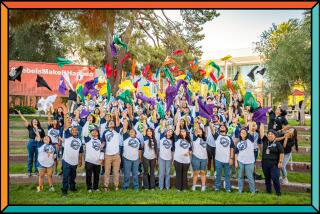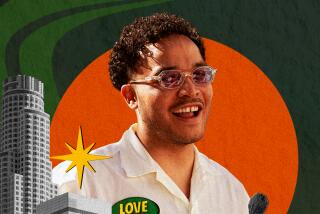Can’t We All Just Get Along? Yes
- Share via
Four Latino boys were chattering in Spanish when a black boy told them to quit speaking Spanish. A verbal argument ensued among these classmates as we drove to a sporting event. From my vantage point as the driver I quelled the debate and asked one of the black boys to explain the problem.
“The Mexicans,” he said, “are always talking about us in Spanish!”
A Latino boy piped up, “No, we’re not!”
In the midst of a back-and-forth fray of accusations, I asked all of the boys for possible solutions to this conflict. One Latino boy said that in his home, if a non-Spanish speaker asked what was being said in Spanish, an immediate translation would be made for the person.
All of the boys agreed that this was a good solution. The Latinos insisted that they be allowed to speak Spanish whenever they chose and the black boys agreed, so long as they could be told at any moment of the content of the discussion.
I asked how this agreement would be enforced at our community center? The boys all agreed that if any person broke any rule (not allowing Spanish, refusing to interpret upon request), that person would be last in line for meals.
I like this story because it conveys both the threat and the hope intrinsic to urban youth work today.
The threat involves demographic transitions throughout Los Angeles County. Anywhere an existing population is overtaken by a new group, there is a threat of escalated tensions.
In northwest Pasadena, where I live, the African American population was surpassed by Latinos earlier this decade. In Los Angeles County, there were 44 cities with a black majority in 1970; only one--Inglewood--has not been overtaken by a Latino majority.
Some say the cause of tension is economic, others say it’s because other forces pit the two groups against each other. What is certain is that we are dealing with many distinct cultures. At times, as in this example with youths frustrated over language differences, these tensions come to the surface.
What is also certain is that there are many blacks and Latinos working hard, not on behalf of themselves alone, but for peaceful relations with the other group.
I am most amazed by young people who have demonstrated courage and stood up against forces of divisiveness.
One young African American, the only black on his high school soccer team, endured a preseason of abuse at the hands of Latinos claiming soccer was not a “black sport” and then a regular season of abuse from black students who claimed this teen was trying to be “blaxican.”
Many in his position would have returned disrespect with disrespect. But this young man persevered, winning respect from all students and opening new avenues for crossing the color line.
Another Latino youth speaks forcefully in public for peace when racial conflict arises. His Catholic faith has taught him that there are principles higher than race that all people must submit to. He is leading a peer group of blacks, Asians and Latinos to his family’s ranch in Mexico, so that his friends may learn about Mexican life, language and culture.
We should all be encouraged by these two young men and by the youths who negotiated their language problem. Theirs is a future of great complexity, and they are already demonstrating an ability to navigate treacherous, cross-cultural terrain. We should all take heart in the youths in conflict over Spanish, for they demonstrated that their pain rose from the conflict itself and not from the ethnic identity of their opposition. It is not a stale platitude to say that these young people are our brightest hope.
*
Rodolpho Carrasco is associate director at the Harambee Center, a neighborhood center in Pasadena. E-mail: rudy@harambee.org.
More to Read
Sign up for Essential California
The most important California stories and recommendations in your inbox every morning.
You may occasionally receive promotional content from the Los Angeles Times.













